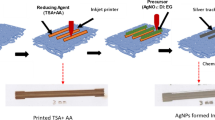Abstract
Non-contact, direct-write aerosol jet (AJ) printing technology using a variety of functional nanomaterial inks has been regarded as one of the most promising approaches for large-area additive manufacturing. The development and atomization of inks have a considerable effect on the printing quality. Therefore, in this study, the effect of a specific ratio of silver nanoparticle ink and a co-solvent of propylene glycol monomethyl ether (PGME) and ethylene glycol (EG) was investigated. The results indicated that the proportion of the solvent in the silver nanoparticle ink could affect the electrical characteristics of the printed lines. The prepared conductive ink with 95% silver nanoparticle ink and 5% co-solvent at a curing temperature of 180 °C demonstrated superior electrical conductivity and adhesion on the substrate.














Similar content being viewed by others
References
Chen J, Liu H, Huang Y, Yin Z (2016) High-rate roll-to-roll stack and lamination of multilayer structured membrane electrode assembly. J Manuf Process 23:175–182
Lee DH, Choi JS, Chae H, Chung CH, Cho SM (2008) Highly efficient phosphorescent polymer OLEDs fabricated by screen printing. Displays 29:436–439
Kopola P, Tuomikoski M, Suhonen R, Maaninen A (2009) Gravure printed organic light emitting diodes for lighting applications. Thin Solid Films 517:5757–5762
Kim K, Ahn SI, Choi KC (2013) Direct fabrication of copper patterns by reactive inkjet printing. Curr Appl Phys 13:1870–1873
Sung J, Kang BJ, Oh JH (2013) Fabrication of high-resolution conductive lines by combining inkjet printing with soft lithography. Microelectron Eng 110:219–223
Özkan M, Hashmi SG, Halme J, Karakoç A, Sarikka T, Paltakari J, Lund PD (2017) Inkjet-printed platinum counter electrodes for dye-sensitized solar cells. Org Electron 44:159–167
Sowade E, Göthel F, Zichner R, Baumann RR (2015) Inkjet printing of UHF antennas on corrugated cardboards for packaging applications. Appl Surf Sci 332:500–506
Molina-Lopez F, Briand D, De Rooij NF (2012) All additive inkjet printed humidity sensors on plastic substrate. Sens Actuators B Chem 166:212–222
Renn MJ, King BH, Essien M, Marquez GJ, Giridharan MG, Sheu JC (2009) Apparatuses and methods for maskless mesoscale material deposition. US Patent 20090114151
Platt HA, Li Y, Novak JP, van Hest MF (2014) Non-contact printed aluminum for metallization of Si photovoltaics. Thin Solid Films 556:525–528
Jones CS, Lu X, Renn M, Stroder M, Shih WS (2010) Aerosol-jet-printed, high-speed, flexible thin-film transistor made using single-walled carbon nanotube solution. Microelectron Eng 87:434–437
Wang FX, Lin J, Gu WB, Liu YQ, Wu HD, Pan GB (2013) Aerosol-jet printing of nanowire networks of zinc octaethylporphyrin and its application in flexible photodetectors. ChemComm 49:2433–2435
Lesch A, Momotenko D, Cortés-Salazar F, Wirth I, Tefashe UM, Meiners F, Vaske B, Girault HH, Wittstock G (2012) Fabrication of soft gold microelectrode arrays as probes for scanning electrochemical microscopy. J Electroanal Chem 666:52–61
Eckstein R, Hernandez-Sosa G, Lemmer U, Mechau N (2014) Aerosol jet printed top grids for organic optoelectronic devices. Org Electron 15:2135–2140
Wang C, Hong GY, Li KM, Young HT (2017) A miniaturized nickel oxide thermistor via aerosol jet technology. Sensors 17:2602
Tait JG, Witkowska E, Hirade M, Ke TH, Malinowski PE, Steudel S, Adachi C, Heremans P (2015) Uniform aerosol jet printed polymer lines with 30 μm width for 140 ppi resolution RGB organic light emitting diodes. Org Electron 22:40–43
Seifert T, Baum M, Roscher F, Wiemer M, Gessner T (2015) Aerosol jet printing of nano particle based electrical chip interconnects. Mater Today 2:4262–4271
Funding
This research was financially supported by the Ministry of Science and Technology (Taiwan) under contract nos. MOST 107-2221-E-002-135-MY2.
Author information
Authors and Affiliations
Corresponding author
Additional information
Publisher’s note
Springer Nature remains neutral with regard to jurisdictional claims in published maps and institutional affiliations.
Rights and permissions
About this article
Cite this article
Hung, KY., Chang, YT., Chien, CH. et al. Investigation of ink modification for aerosol jet printing process on FR-4 substrate. Int J Adv Manuf Technol 111, 1147–1156 (2020). https://doi.org/10.1007/s00170-020-06186-w
Received:
Accepted:
Published:
Issue Date:
DOI: https://doi.org/10.1007/s00170-020-06186-w




